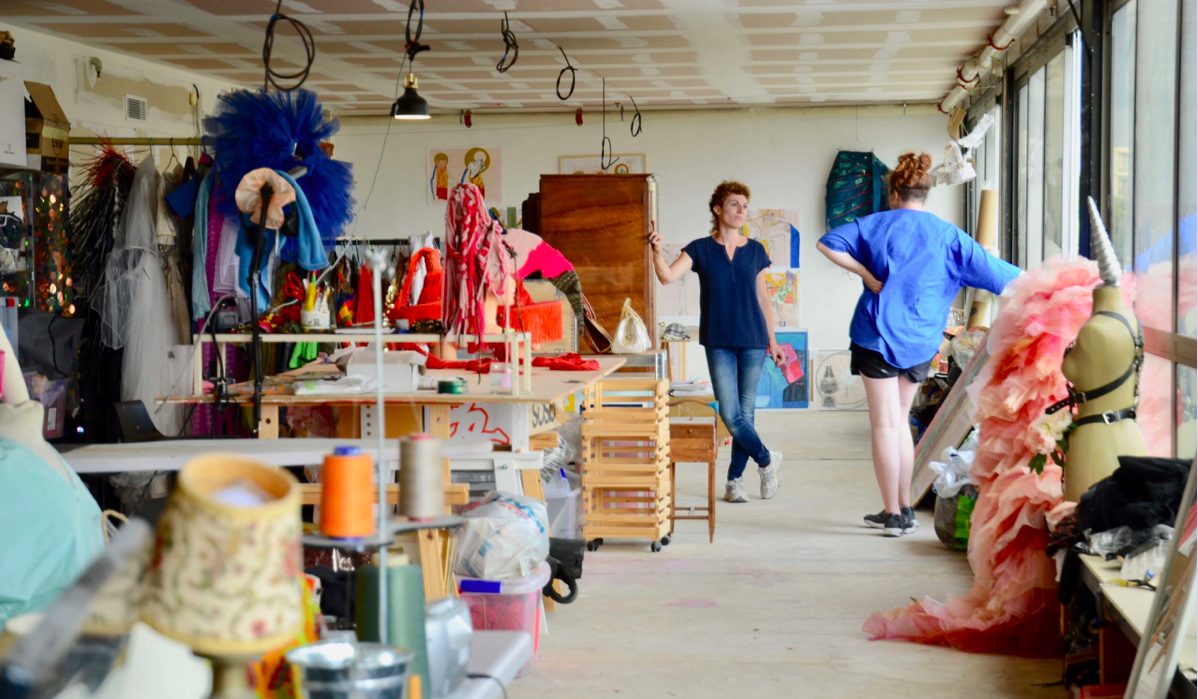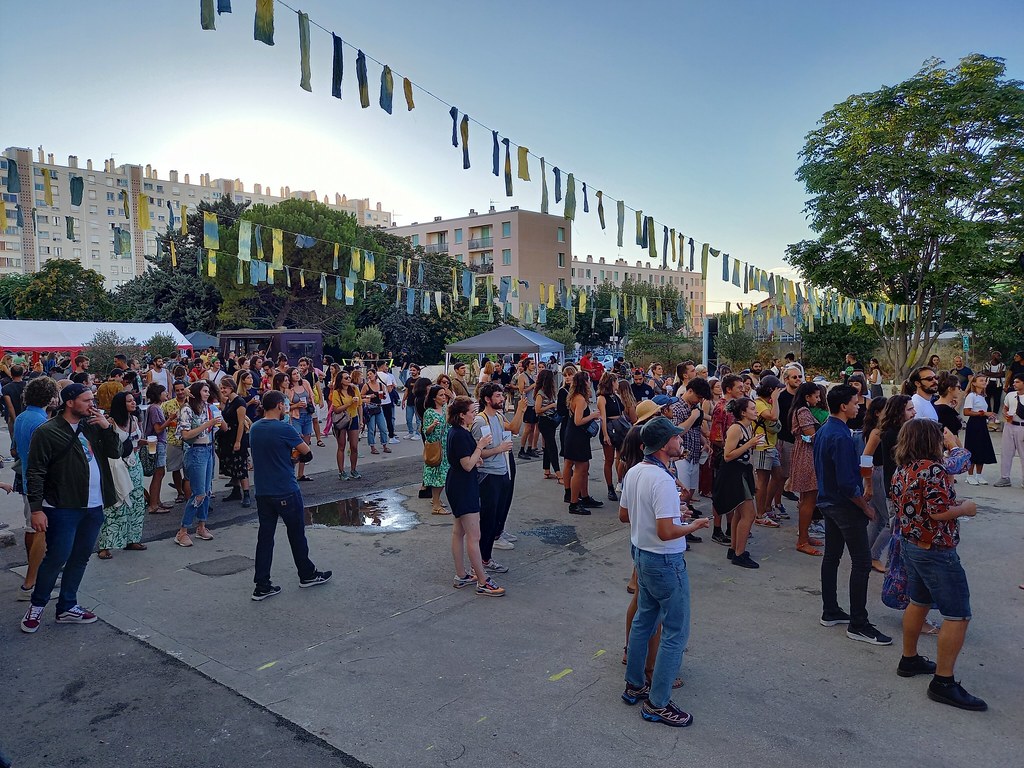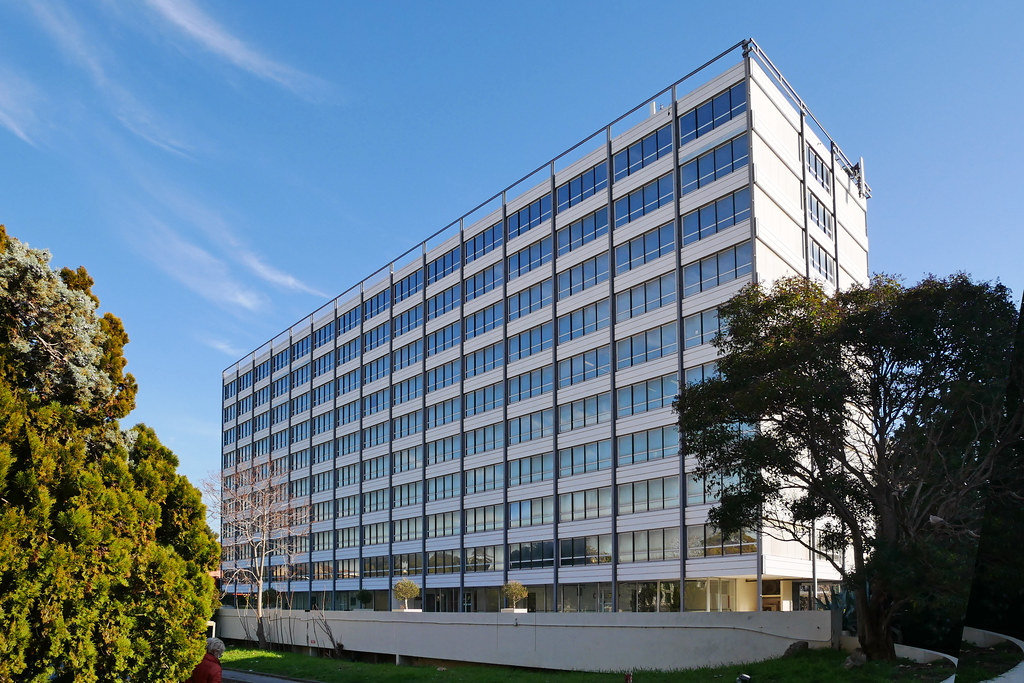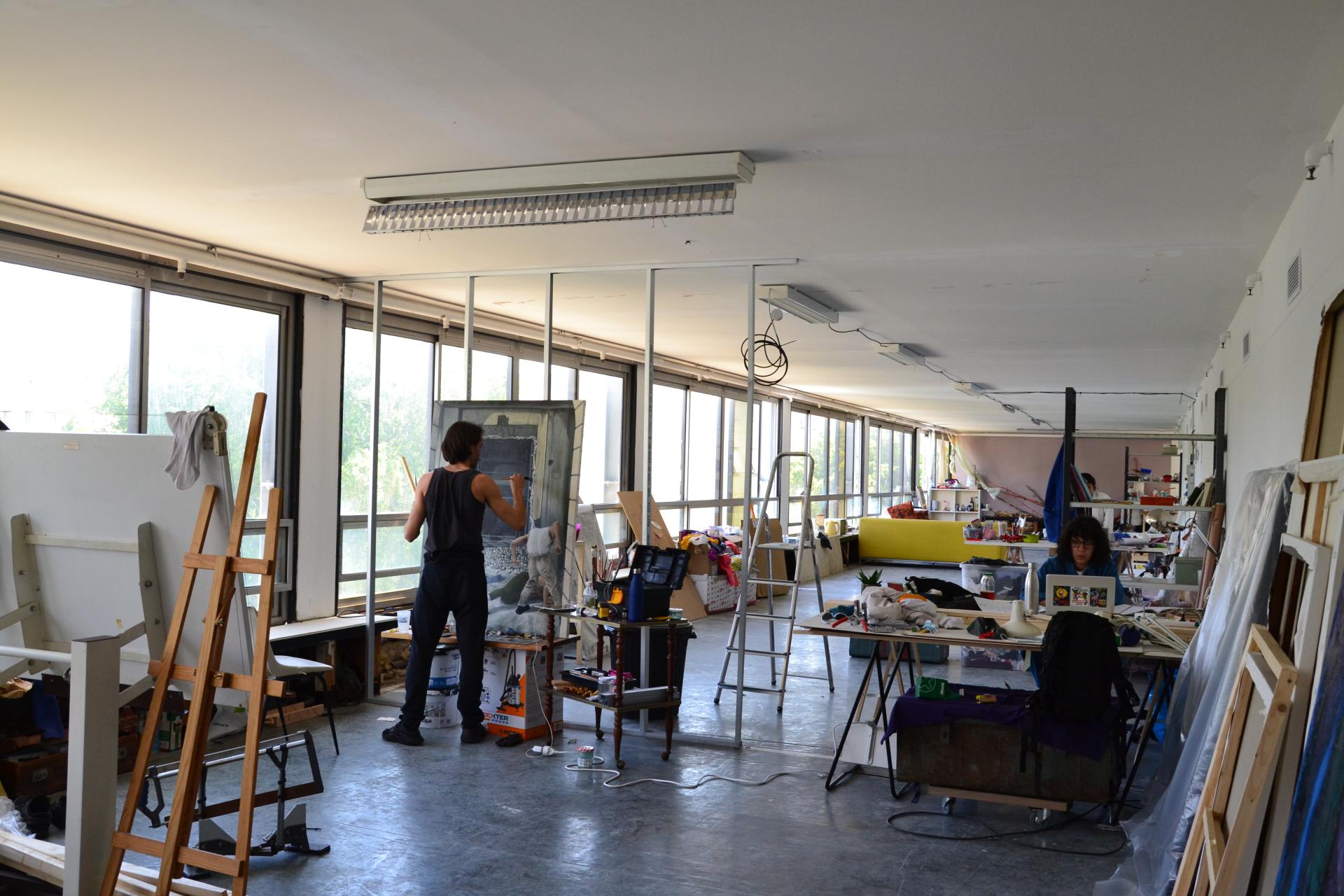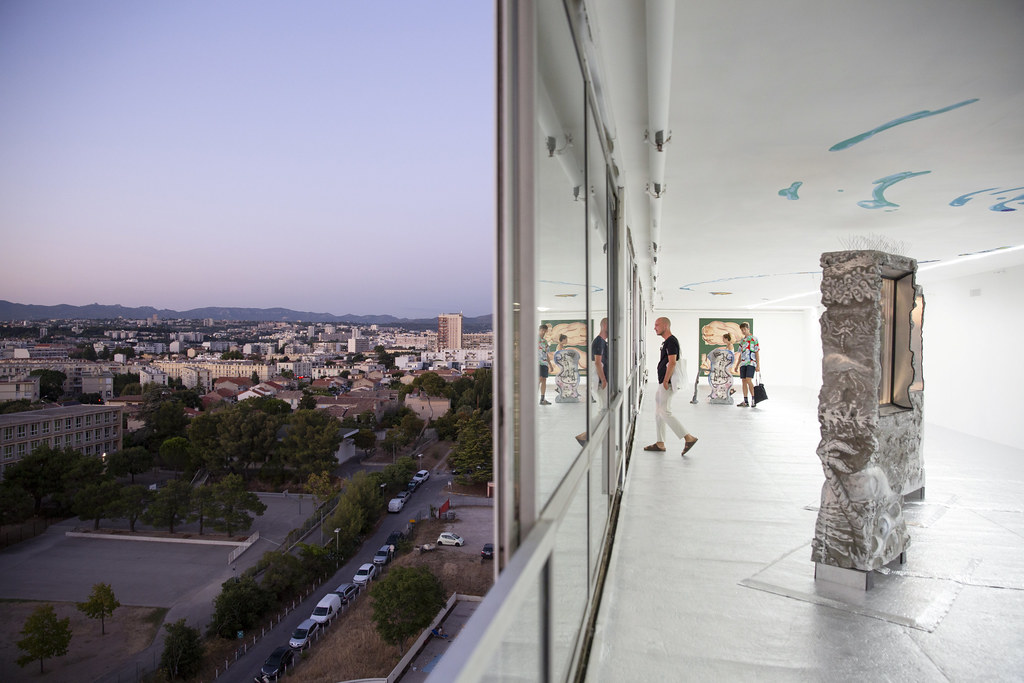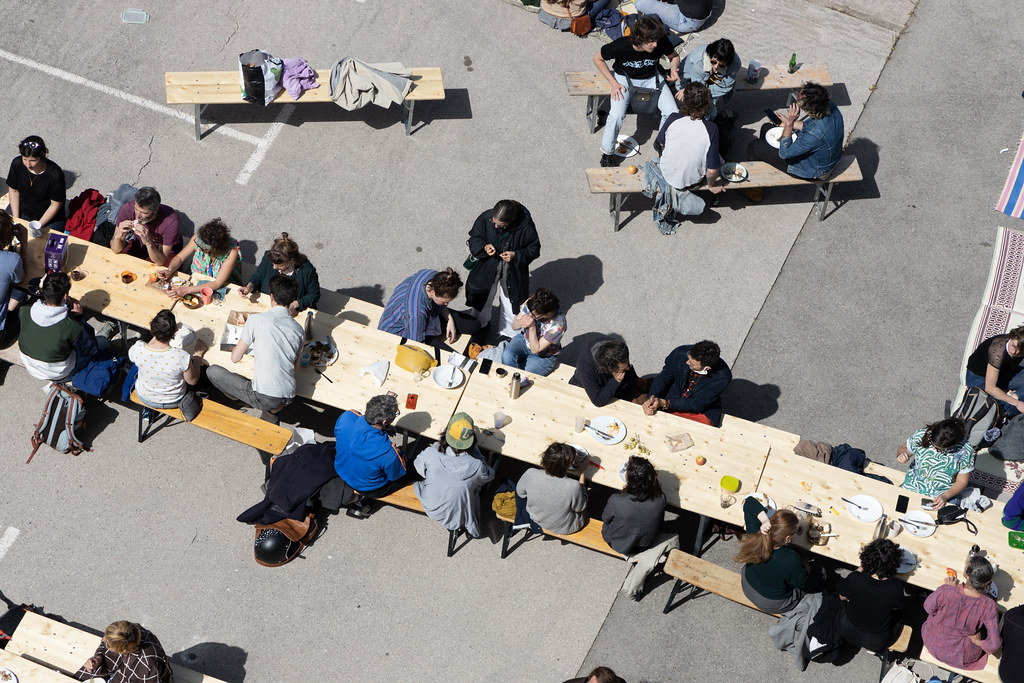Buropolis
Basic information
Project Title
Category
Project Description
Buropolis is a shared artistic production space bringing together 250 artists, craftsmen and architects in a former office building in Marseille. Produced by the manifold involvement of its occupants working in a logic of co-construction and transversality, this temporary and experimental project provides work spaces but is also an attempt to create a hybrid and “permacultural” art space that enables artistic practices to influence the way an environment is made.
Geographical Scope
Project Region
Urban or rural issues
Physical or other transformations
EU Programme or fund
Which funds
Description of the project
Summary
Since 2013, the Yes We Camp association has been putting into place processes to transform defined spaces into open, generous and creative micro-territories. These temporary projects bring together people from a wide array of backgrounds wishing to be part of a common project. In this way, we see the city as a fertile terrain, where spaces are shared with confidence and constitute a source of individual fulfilment and development, as well as one of collective benefit. Today, the permanent team, based in Marseille and Paris, counts a number of achievements such as Les Grands Voisins (presented at the French Pavilion of the Venice Architecture Biennale in 2018) as well as Coco Velten in Marseille. In 2020, the association was also awarded the Palmarès des Jeunes Urbanistes prize, delivered by the French Ministry of Ecological Transition.
The latest project, which runs from January 2021 to June 2022, is Buropolis. It is a shared artistic production space bringing together 250 artists, craftsmen and architects in a former office building in Marseille. Produced by the manifold involvement of its occupants working in a logic of co-construction and transversality, directly in line with that of the Bauhaus, this temporary and experimental project provides work spaces, but also has the desire to be a place of cultural programming led by its residents. Buropolis is an attempt to create a hybrid and “permacultural” art space in which artists have traditional production and exhibition spaces at their disposal, but also the possibility to artistically take charge of all aspects of daily life: eating, learning, gardening, meeting, etc. It is a place of work and life that enables artistic practices to influence the way an environment is made and which also offers a space for discourse regarding large-scale art spaces managed in a horizontal and collective manner and, more broadly, on the role of artists and production spaces on an urban scale.
Key objectives for sustainability
Yes We Camp specialises in “inventive uses of available spaces”. Current mechanisms for making and managing cities stifle the possibilities for spontaneous appropriation and invention by those who live in or use these spaces daily. Citizens interface with public and private service providers; they are seen as consumers or beneficiaries. Buropolis is an attempt to change this by enabling everyone to become a “local co-producer” of everyday services, in this case, artistically. This doesn’t mean new tasks and obligations or of legitimising a rollback of public services; it is about making better use of resources and cohabitations, of trusting in the presence of others to create natural reciprocities.
As such, Buropolis is a circular, modest and collective response to the lack of artistic production spaces in the city of Marseille. Rather than developing concrete-heavy and sprawl-generating urban projects, we tap into the force of the existing — we transform it, we inhabit it. Real estate vacancies represent millions of unused square metres in France; construction is responsible for 40% of CO2 emissions. At the same time, artists and social actors, with strong potential impacts for societal change, need space to develop projects that will contribute to the world of tomorrow. At Buropolis, 16,000 m2 of space has been made available to meet this real need.
In a logic of ecological transition, Buropolis acts as a prototype: industrial wastelands have greatly impacted artistic forms over the last decades with the third-sectorisation of the economy and have long constituted an available land resource for artists on the fringes of the traditional urban fabric. Today, with new working habits generated by the rise in self-employment and teleworking, it can be assumed that office buildings will be the next available land resource. This project demonstrates how other uses beyond their primary vocation are possible to avoid the classic approach of demolition and reconstruction.
Key objectives for aesthetics and quality
The approach to aesthetics and quality of experience that presides over the project is that of a “permacultural” art space. In this allegory, places of “monoculture” are those based on a certain history of art such as Brian O’Doherty’s theory of the white cube, or the way in which Clement Greenberg’s theories on the question of the autonomy of art from the social field have been interpreted — places dedicated to art in which everything else is excluded. In contrast, a “permacultural” space means working on artistic practices in the shadow of others: sociability, space planning, eating well, building well, cultivating a garden. It is about seeing artistic production as a fertile ecosystem rather than as works of art. At a time when climate change is shifting paradigms, Buropolis is a space of hybridisations arising from the cohabitation of a diversity of forms carried by 250 artists and which infuse even the smallest details of daily life.
Another important aspect of the project is the transversality and cooperation of artistic professions, which is also a hallmark of the association’s members. Visual artists, object and graphic designers, craftsmen (ceramists, luthiers, risographers, etc.), architects and theatre companies work in and cohabit the space. In the tradition of the Weimar Bauhaus, this cohabitation of practices in the same place allows for bridges and hybrid forms to develop, without any question of hierarchy. Thus, as the project progresses, from the myriad practices come shared projects.
Aesthetically, the project’s building boasts a strong architectural heritage, designed by Marcel Lods and the G.E.A.I. (Groupement d’études pour une architecture industrialisée); and its all-metal structure provides excellent work and exhibition spaces, the latter being entirely glazed and offering panoramic views of the Mediterranean city. The building’s twin, located in Villeurbanne, was notably awarded the Remarkable Contemporary Architecture label.
Key objectives for inclusion
Yes We Camp creates fertile cohabitations, enabling people who typically do not cohabit to invest in a shared project. With artistic practices and emergency housing being aspects of both Les Grands Voisins and Coco Velten, social work is integral to our projects, facilitated by our strong interdisciplinary nature.
Buropolis continues this approach. Instead of a typical competitive call for projects, we opted for a broad application process, without a selection committee, to include the widest array of disciplines and to avoid any potential elitism. This inclusive format was made possible by the extensive surface area, and thus work spaces, available. The strength of Buropolis is thus in the diversity of its public: intergenerational, trans-disciplinary. Some of the artists have international careers, others are young professionals; and these artists cohabit with the elderly, retirees as well as many newcomers.
Located in a difficult neighbourhood, the project also aims to embrace local dynamics without creating a project that is out of its depth. To meet this challenge of territorial networking are proposals such as courses led by the project’s residents for local children and teens as well as the creation of a media library for children from the Huveaune Valley, an area of Marseille known for its poor cultural offerings.
Partnerships are also being made with local social structures. One, with the Ecole de la Deuxième Chance, which reintegrates youth (many with no qualifications or are school drop-outs) into society through work, offers internships at Buropolis so these youth can discover the artists’ process from the inside, rather than via traditional means. Many artists are also giving classes in a nearby experimental emergency social centre called L’auberge Marseillaise. And at Buropolis, Kourtrajmé introduces disadvantaged youth to the film industry and the project’s two security guards are ambassadors for Le Carillon, which offers service to the homeless.
Results in relation to category
The city of Marseille is experiencing a true cultural effervescence, concomitant with two major European events: the European Capital of Culture in 2013 and Manifesta 13 in 2020. Its quality of life, low rental prices and vibrant artistic scene has made it appealing to many young artists on a French and European scale. Proof of this can been seen in the enthusiasm generated by the call for applications for the Buropolis project and the cosmopolitanism of the resident artists. The possibility of trying — as a group — to invent a new kind of art space with a co-managed exhibition, teaching and production area, has led to an immense collective will in a very short time.
The solitude of contemporary artists is high, especially in an art economy and system of call for projects that often puts them in competition rather than in a position of cooperation. Buropolis aims to reinvent artistic production spaces in a logic of new cooperations, mutualisation and openness. A number of artists initially joined the project simply because they needed spaces for artistic production, but they gradually embraced the dynamic of shared governance to the point of turning down other work spaces, even if they were less expensive, because they felt part of a community.
Buropolis functions daily through a system of shared governance that was set up with the help of the association Gouvernons!, which specialises in citizen participation. Each of the artists has offered to participate in the management of the project’s various areas, in the service of others: exhibitions, event programming, gardening and culture, shared workshops and the transmission of knowledge. The cleaning and maintenance tasks are also shared and the renovation of the place is gradually carried out during collective work camps. To illustrate this point, so that the premises could be used, the work to bring the building up to fire code standards mobilised a hundred people over a month.
How Citizens benefit
Buropolis is a temporary project born from the collaboration of numerous stakeholders, many from civil society. The building’s current owner is a private office space lessor, the Compagnie Vauban, who chose to sign a temporary occupation agreement rather than see this 16,000 m2 building go empty with a one-year vacancy period obliging it to wall-off and guard the property.
Yes We Camp bears the financial risk of the project and engages its expertise by ensuring communication and the link to the various institutions. It signed the main occupation agreement directly with the owner and then signed subleases with each occupying artist.
The project, which represents a budget of €1.2m over 18 months, is possible thanks to the participation of another association, the French Red Cross, which has set up a nursing training institute on-site and thus represents a major financial contribution. Self-financed at 80%, the fees paid by Buropolis’ occupants cover most of the building’s costs. The remaining 20% comes from various local authorities (City, Department, etc.), who also provide advisory services. A steering committee comprised of the project’s partners, including the City of Marseille’s art school, provides a framework for analysing the impact of the project, and studies possible ways of relocating the entire community and its operations elsewhere in the city.
The project directly benefits 250 artists, who are both citizens and committed members of a project that goes beyond their individual practices. The proposed courses, reading space, exhibitions, the transformation of outdoor spaces and the provision of vegetable gardens directly benefit the neighbourhood, as Buropolis is located in the Huveaune Valley, which has been described as a “cultural desert” due to its limited cultural venues. And lastly, the project reaches a wide public, with people coming from across the metropolis to attend the exhibitions, performances and meetings organised by the resident artists.
Physical or other transformations
Innovative character
The innovative character of this project lies first of all in a mechanism of transitional urbanism applied to an entire office building for artistic purposes. Yes We Camp is well experienced in making vacant land available for short periods of time (wastelands, former hospitals), but the unprecedented scale of this project for cultural purposes is for us decisive. With the consequences of the global pandemic, the new ways of working brought about by third places, the generalisation of freelancing and the increase in teleworking; the use of this office building can act as a prototype for the creation of a collaborative artistic community whose need for artistic production spaces is often found in neglected urban areas.
More broadly, this is a reflection in which Yes We Camp is deeply engaged through its work with Nouvelles urbanités, a group which came to be during the “lieux infinis” exhibition at the French Pavilion of the Venice Architecture Biennale in 2018. As twenty-some actors sharing a unique view on the issue of urban planning in France, we collectively ask the question of the use of the existing, the transformation of the built environment through modest and socially impactful mechanisms, especially when the construction industry is responsible for 40% of CO2 emissions.
We would also like to emphasise the innovative nature of the system of shared governance that has been put in place. Despite its size, the project only employs four people, because it is the sum of the voluntary involvement of its occupants that makes its existence possible, and the sharing of tasks relating to the development of the spaces and programming that allows for frugality of expenditure. The sum of these efforts, including the possibility for the artists to become “co-producers” of their workplace, co-managers of the exhibition and classroom spaces, opens up the possibility of thinking of a new kind of art space offering hybrid artistic forms, integrated into a shared daily life.
Learning transferred to other parties
The Buropolis project has opened the path to discussing, on the scale of the city of Marseille and in close collaboration with local authorities, the sustainability of artistic creation spaces via collective ownership mechanisms or partnerships with social property lessors. Various artistic communities could thus become involved in the construction of shared spaces and, once an economic and governance model has been established and the necessary investments have been made, the land could be purchased via a Société Collective d'Intérêt Commun. Local authorities could buy shares in support of artistic practices, artists could invest in their place of production for the long term, and the citizens who benefit from the exhibitions and cultural programming could become more involved and thereby participate in perpetuating a production space when the transitory use of spaces is often precarious.
In addition, Yes We Camp has created a French university diploma specialising in “Shared Spaces”, in partnership with the Gustave Eiffel University. Aimed at encouraging the proliferation of these shared spaces, it creates learning collectives that bring together people from various backgrounds (profiles, disciplines, sectors, professional maturity, etc.) — the actors of these transformations, who share the desire to be at the heart of this evolution, to contribute to its maturation and definition, and who seek to promote the use of available spaces and resources. This diploma contributes to the dissemination, in France, of the models tested during the Buropolis project, notably around the architectural and regulatory issues related to the use of vacant space as well as those of shared governance and collective decision-making, with the aim of creating an archipelago of connected spaces capable of working together on the social transition that is necessary today.

